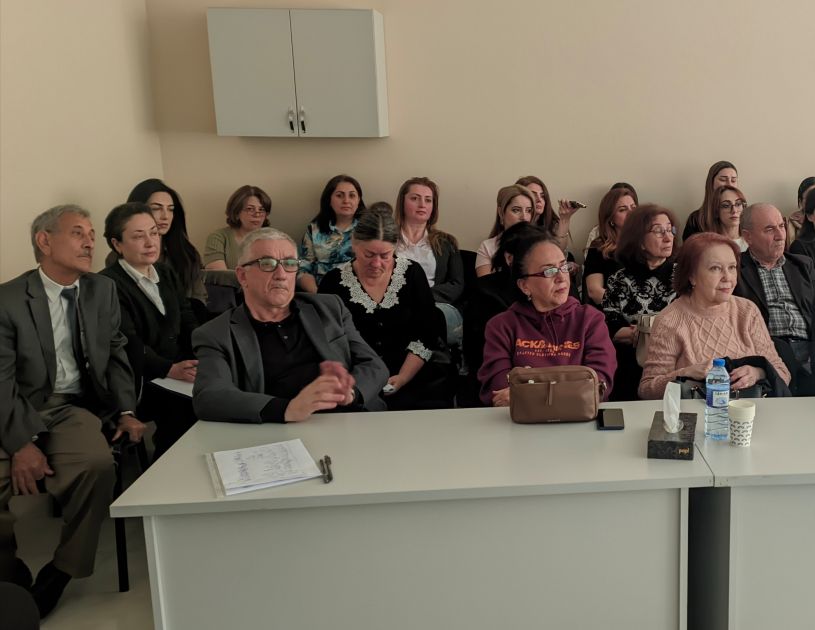Biophysics Institute holds scientific seminar [PHOTOS]
![Biophysics Institute holds scientific seminar [PHOTOS]](https://www.azernews.az/media/2025/04/27/17455011421114264005_1200x630.jpg)
A scientific seminar titled "Aqueous Two-Phase Systems and Their Application Prospects" has been held at the Biophysics Institute of the Azerbaijan Ministry of Science and Education, Azernews reports.
The seminar featured Dr. Eldar Masimov, a Doctor of Physical and Mathematical Sciences and Professor of the Department of Substance Structure at Baku State University.
Attendees included Professor Niftala Hojayev from the Department of Optics and Molecular Physics of the Baku State University (BSU) Physical Faculty, staff members from the Biophysics Department of the Scientific Research Institute of Physics Problems at BSU, as well as university graduate students.
The seminar was opened with a welcoming speech by Oktay Gasimov, the General Director of the Biophysics Institute and Corresponding Member of the National Academy of Sciences of Azerbaijan (NASA). He warmly greeted the participants and emphasized the significance of the seminar topic in the fields of science and education. He stressed the necessity of a thorough investigation of both theoretical and practical aspects of this subject and requested Professor Eldar Masimov to elaborate on the theoretical and functional dimensions of the issue.
The General Director also expressed hope that future seminars would serve as a source of interesting and useful ideas from a scientific and technological perspective. He acknowledged Professor Eldar Masimov’s extensive experience and expressed deep respect for his academic work.
During his presentation at the Biophysics Institute, Professor Eldar Masimov highlighted the crucial role of water in living organisms and the importance of two-phase systems in this context. He explained that water functions not only as a solvent but also directly influences biological and biochemical processes. The professor elaborated that hydrogen bonds between water molecules and the dynamic structures that arise from these interactions are responsible for these effects.
E. Masimov emphasized the unique properties of water and noted that they can be explained by its physical and physico-chemical anomalies. He pointed out that extremes in properties such as density, surface tension, and dielectric constant distinguish water from other liquids. The two-structural fluid model, which underlies these properties, was proposed by Bernal and Fowler and has since been further developed by many scientists.
The speaker indicated that two-phase systems are based on the principle of non-uniform distribution of substances, and this approach opens new opportunities for effective separation and analysis of components, particularly in biological environments. He stressed that the use of two-phase systems for analytical, preparative, and diagnostic purposes paves the way for innovative applications in medicine and biotechnology. One of the significant advantages of this method is the ability to study living systems under conditions that closely resemble natural settings.
Professor Masimov also paid special attention to the concept of the "hydrophobic effect." He explained that this effect, observed when nonpolar substances or those with nonpolar groups interact with water, can be understood in terms of Gibbs free energy. At the molecular level, the ratio of hydrophilic to hydrophobic groups determines the solubility and functional characteristics of biological molecules in water.
The scientist also discussed the properties of polymeric and electrolyte two-phase systems. In these systems, the aqueous phase is hydrophilic, while the nonpolar phase is hydrophobic.
The distribution of substances is related to differences in hydrophobicity between the phases. He pointed out that these systems are important for assessing the hydrophobicity of substances in biological and pharmacological studies, as well as for measuring the impact of substances that change their structure in an aqueous environment.
E. Masimov also highlighted the significant role of two-phase systems in the separation of biological particles. He emphasized that such systems operate very "gently" and non-invasively. Additionally, he noted that these methods can be utilized as indicators of pathological changes.
Following the presentation, the General Director of the Biophysics Institute, Corresponding Member of NASA Oktay Gasimov; Professor Niftala Hojayev; Executive Director of the Biophysics Institute, Doctor of Biological Sciences Kerim Gasimov; Associate Professor, Candidate of Biological Sciences Taleh Yusifov; Doctor of Physical and Mathematical Sciences Gulnara Hagverdiyeva; and Candidate of Physical and Mathematical Sciences Khaver Hasanova expressed their questions and opinions regarding the seminar topic.
Here we are to serve you with news right now. It does not cost much, but worth your attention.
Choose to support open, independent, quality journalism and subscribe on a monthly basis.
By subscribing to our online newspaper, you can have full digital access to all news, analysis, and much more.
You can also follow AzerNEWS on Twitter @AzerNewsAz or Facebook @AzerNewsNewspaper
Thank you!


